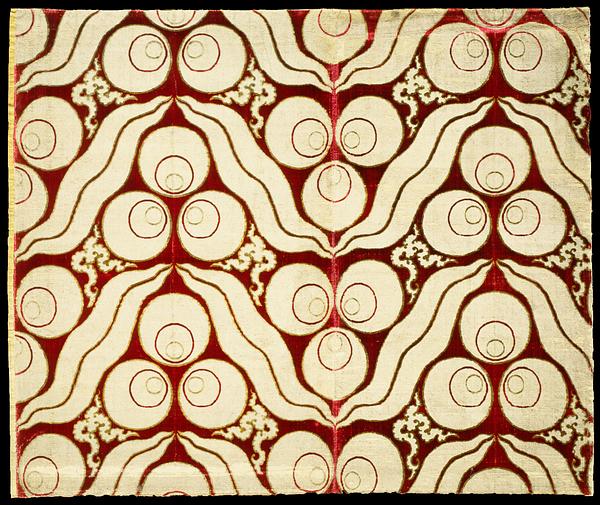Velvet with a chintamani pattern, silk and metal lamella
Turkey; mid-16th century
H: 95; W: 114 cm
The chintamani pattern is most often associated with the art of the Ottoman Empire, but it is older and probably originated with the Central Asian Turkic peoples. It has been convincingly interpreted as a combination of the tiger’s stripes and the leopard’s spots, and as such refers especially to manly courage.
The pattern is found in different variations, and both the number of the elements and their position may differ. In this striking example, each spot was given two extra spots and the stripes were placed diagonally. In addition, an almost octopus-like Chinese cloud ornament was added.
The famed Ottoman textile industry had its center in Bursa, but many of the patterns were designed in the royal studio in Istanbul.
Inv. no. 25/1962
Published in:
C .L. Davids Samling. Fjerde Del : Jubilæumsskrift 1945-70, København 1970, fig. 1, p. 226;
André Leth: Davids Samling. Islamisk kunst = The David Collection. Islamic Art, København 1975, p. 118;
Art from the World of Islam. 8th-18th century, Louisiana, Humlebæk 1987, cat.no. 201;
Friedrich Spuhler: "Art from the world of Islam, in Hali, 1987, 35, p. 50;
Soliman le Magnifique:15 fevrier au 14 mai 1990, Galeries Nationales du Grand Palais, Paris 1990, cat.no. 223;
Kjeld von Folsach: Islamic art. The David Collection, Copenhagen 1990, cat.no. 401;
Kjeld von Folsach and Anne-Marie Keblow Bernsted: Woven Treasures: Textiles from the World of Islam, The David Collection, Copenhagen 1993, cat.no. 23;
Kjeld von Folsach, Torben Lundbæk and Peder Mortensen (eds.): Sultan, Shah and Great Mughal: the history and culture of the Islamic world, The National Museum, Copenhagen 1996, cat.no. 366;
Kjeld von Folsach: Art from the World of Islam in The David Collection, Copenhagen 2001, cat.no. 652;
Sheila S. Blair and Jonathan M. Bloom (eds.): Cosmophilia. Islamic Art from the David Collection, Copenhagen, McMullen Museum of Art, Boston College, Boston 2006, cat.no. 45;
Michal Wasiucionek: “Vesmantul imparatului: caftanul ottoman in epoca premoderna” in Constanța Vintila et al.: Lux, moda si alte bagatele politicesti in Europa de Sud-Est, in secolele XVI–XIX, Bucuresti 2021, p. 173;
